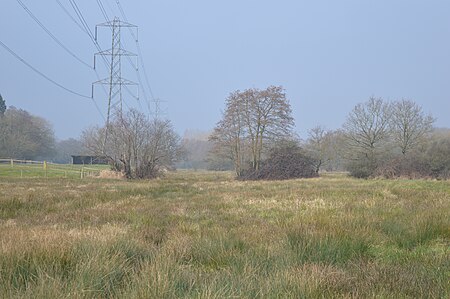The Albert R. Broccoli 007 Stage is one of the largest sound stages in the world. It is located at Pinewood Studios, Iver Heath, Buckinghamshire, England, and named after James Bond film producer Albert R. "Cubby" Broccoli.
The stage was originally conceived in 1976 by production designer Ken Adam to house the set he had designed for the interior of the Liparus supertanker in the James Bond film The Spy Who Loved Me. The stage's construction cost $1.8 million. During filming, Adam told American Cinematographer that other filmmakers were interested in using the new "007 Stage". During a ceremony attended by former British Prime Minister Harold Wilson, Roger Moore and other The Spy Who Loved Me actors, and many actors who had worked at Pinewood including Hayley Mills and Kenneth More, Broccoli's wife Dana christened the stage by breaking a champagne bottle on one of the submarines in the film on 5 December 1976. In contrast to the volcano crater set Adam had built for You Only Live Twice in 1966, the 007 Stage was to be a permanent structure that could be rented out to other productions.
The 1976 stage measured 102 by 41 metres (335 by 135 ft) and was 12.5 metres (41 ft) high. It had a maximum 4,220 square metres (45,400 sq ft) floor space. The stage featured a water tank measuring 91 by 22.5 by 2.7 metres (300 by 74 by 8.9 ft). According to 007stage.com, the water tank was an existing studio feature and the stage was created by constructing a building to completely enclose the tank. Technically, because it had no soundproofing, it was a "silent stage", the largest ever built.The 007 Stage burnt to the ground on 27 June 1984 towards the end of filming of Ridley Scott's Legend. It was rebuilt, and reopened in January 1985, with the new name, "Albert R. Broccoli 007 Stage", in time for filming to commence on A View to a Kill (1985).
Another fire occurred on 30 July 2006. The fire occurred just after production ended on the Bond film Casino Royale while the Venetian piazza set was being dismantled. Eight fire engines took 90 minutes to bring the fire under control; a spokesman for the local fire brigade said gas canisters may have exploded inside the building. Filming had been completed on the stage several days before and it was being dismantled, so it did not delay production or release of the film. The damage to the building was extensive, causing the roof of the building to collapse. On 31 July 2006, Pinewood issued a statement indicating that the stage "will need to be demolished and rebuilt" and that there had been no casualties in the incident. The fire-damaged stage was demolished on 13–14 September. Construction on the new stage began on 18 September and was completed in under six months. The new stage was redesigned and included a number of new features including an increased working floor space area, enclosed stairwells to the gantry, a vehicle ramp into the tank, aircraft hangar-style loading doors, increased electrical power and better insulation. The new stage is 374 by 158 feet (114 by 48 m) and 41–50 feet (12–15 m) high. The stage is the biggest in Europe at around 59,000 sq ft (5,500 m2).An explosion shot in the sound stage on 4 June 2019 caused extensive damage to the external wall of the stage.










